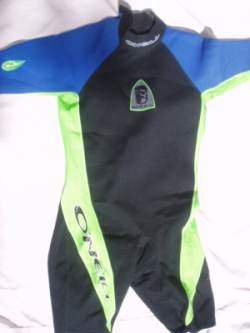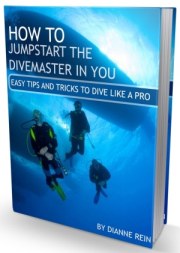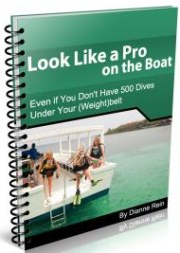Wetsuit Thickness:
A Guide to Keep You Warm and Toasty
|
|
You want to keep warm during your dive but what is the right wetsuit thickness to do the job? After all, nothing can ruin a dive faster than being cold and shivering while you are underwater.
(Take a look at our wetsuit buyers guide for a complete list of all our pages and information on wetsuits.)

The proper thickness basically depends on where you will be diving and your tolerance for cold. The thicker the wetsuit, the warmer you will be.
If you are not sure between 2 thicknesses, I would probably buy the thicker wetsuit. You can let water in to get cooler but you can't make it warmer.
It should be noted that some wetsuits have 2 different thicknesses on different parts of the body. A 5/3 mm wetsuit thickness means there would be 5 mm on the torso and 3 mm on the arms and legs.
Just remember, there is no hard and fast rule here as far as thickness goes. I could be hot as Hades in a 3mm and you could be Frosty the Snowman. Also, the neoprene compresses at depth so you will have less insulation the deeper you dive.
Enough said, here's a general guide to help you determine what might be the proper thickness for your wetsuit:
- 2 mm: Water temperatures above 85 F; my shorty is 2 mm and it is fine for me in the Caribbean
- 3 mm: Water temperatures between 70-85 F; this is usually the norm for scuba diving in the Caribbean
- 5 mm: Water temperatures between 60-70 F
- 6.5 mm Water temperatures between 50-70; at the lower end you are getting into drysuit territory.
Remember, this is just a general guide. If you are not sure, you can always rent a wetsuit during your next dive vacation and see what thickness works for you. This way you can try a couple of different thicknesses out and determine which is best for you.
For more information, check out our other pages on wetsuits:
Scuba Diving Wetsuits Introduction //How to Buy a Wetsuit //How to Put on a Scuba Diving Wetsuit //Scuba Diving Wetsuit Repair Guide //Wetsuit Care //Wetsuit Material Guide //Guide to Wetsuit Sizes and Fit //Best 3mm Wetsuits - High End or Top End//Best 3mm Wetsuits - Mid-range or inexpensive//Cheap Wetsuits - Men//Cheap Wetsuits - Women
If you are looking to buy a wetsuit, we have full length wetsuits, shorty wetsuits, and farmer john/jane wetsuits available in our Gear Store.
Whichever thickness you choose, I wish you a warm and enjoyable dive.
What's New
-
Happy New Year
Jan 01, 24 06:00 AM
Happy New Year everyone! I hope everyone is well and had a fun New Years Eve! May your new year be filled with lots of wonderful dives. All the best to you and yours in 2024! Let the dives begin. -
Happy Holidays
Dec 14, 23 05:05 AM
I hope everyone is enjoying the holiday season! I am always amazed at how fast time flies and another year is just around the corner. I wanted to pop in and say hi to everyone. I am doing some full ti… -
3 Common Scuba Diving Mistakes New Divers Make
Feb 23, 23 02:18 PM
In this video, I share 3 common scuba diving mistakes beginner divers make. Learn how to correct these for a better - and safer - dive. -
Scuba Diving Tipping Etiquette: How Much And When To Tip Scuba Crew
Feb 06, 23 03:34 PM
Not sure of scuba diving tipping etiquette? In this video I share who to tip, when to tip, how much to tip, tipping on liveaboards, tipping an instructor & more -
Scuba Diving Tips For First Time
Jan 29, 23 05:41 PM
These scuba diving tips for first time divers will help improve buoyancy control, air consumption, equalization and boat diving. Improve on your very next dive!
















New! Comments
Have your say about what you just read! Leave me a comment in the box below.